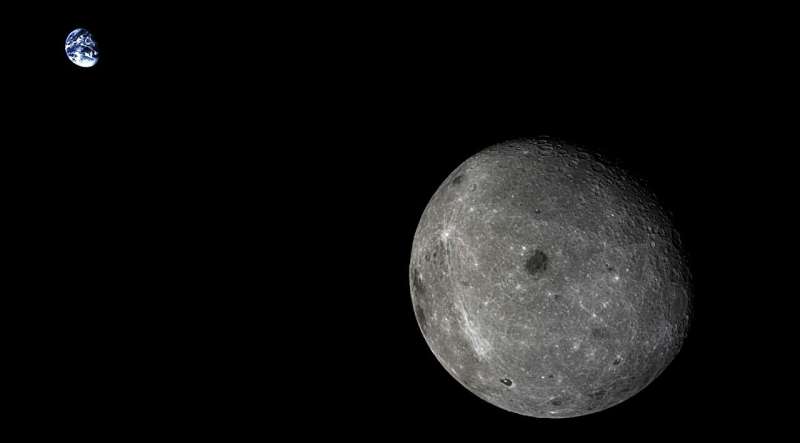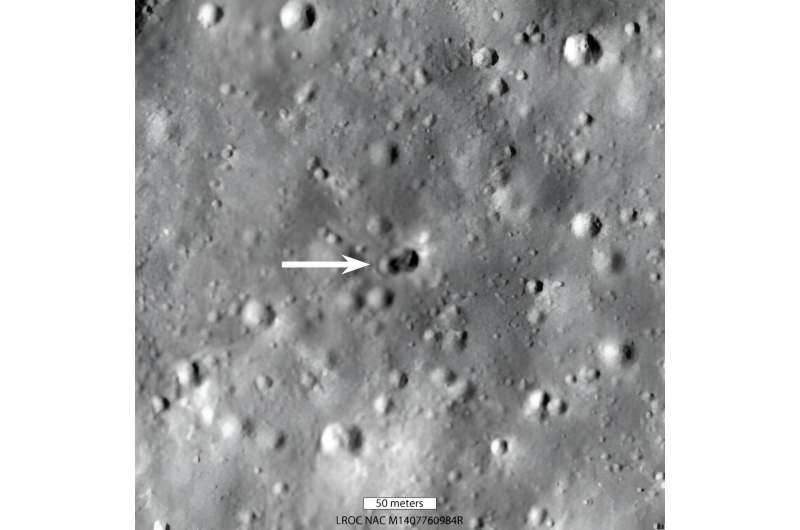This article has been reviewed according to Science X's editorial process and policies. Editors have highlighted the following attributes while ensuring the content's credibility:
fact-checked
peer-reviewed publication
trusted source
proofread
Tracking an errant space rocket to a mysterious crater on the moon

In March 2022, a defunct part of a space rocket hurled toward the moon's surface and impacted near the Hertzsprung Crater, an enormous impact feature on the far side of the moon that is never directly visible from Earth.
Curiously, and unlike any other space hardware that ended up on the moon's surface, this one left behind not one but two craters, causing speculation about what exactly it was that found its final resting place on the moon's surface, according to Tanner Campbell, a doctoral student at the University of Arizona Department of Aerospace and Mechanical Engineering in the College of Engineering and the study's first author.
In a paper published in the Planetary Science Journal, a team of researchers at UArizona provides the definitive proof that the object was a booster from a Chinese space rocket that had spent several years tumbling through space. The study also found that the abandoned rocket stage likely carried an undisclosed, additional payload.
The moon is no stranger to what one could call high-tech littering—the remains of spacecraft slamming into the moon after they have ended their journeys through space. Several rocket boosters from NASA's Apollo missions are just a few examples of space hardware that future astronauts might stumble on while exploring the cold, quiet and airless lunar landscape.
Seven years prior, researchers at the UArizona-led Catalina Sky Survey, one of the world's leading programs tasked with detecting and studying asteroids that could pose a hazard to Earth, discovered an object as it moved at a brisk pace between Earth and the moon. They assigned it the designation WE0913A, but its identity was unknown.
Based on its path through the sky, WE0913A was initially thought to be an errant SpaceX Falcon 9 rocket booster from a 2015 launch, with a trajectory that put it on a path to hit the moon. Initial observations with the Raptor Telescope, which was built by the student team, and spectral analysis soon tracked the precise light signals bouncing off the object's surface.
They concluded that WE0913A's light reflection signature and the way it moved through space made it more likely to be a booster from a Chang'e 5-T1, a rocket launched in 2014 as part of the Chinese space agency's lunar exploration program. While the Chinese space agency claimed the rocket booster burned up in Earth's atmosphere upon re-entry, the U.S. Space Command confirmed the rocket's third stage never re-entered the Earth's atmosphere.
Designed as a dry run for a mission to bring a sample of lunar soil back to Earth, the Chang'e 5-T1 was an experimental, robotic spacecraft riding atop of a Long March 3C rocket. The third and uppermost stage of that rocket is the object that was later identified as object WE0913A by the Catalina Sky Survey. The booster provided the thrust that propelled the payloads toward an orbit around the moon. Once spent, it jettisoned the orbiting module and sample return capsule and was then left to its own devices, a typical procedure for rocket boosters after they have fulfilled their duty.
While the rocket booster is too small to be resolved even by a high-powered telescope, the observations yielded a characteristic light curve of brightening and dimming, caused by its rotation.
"As the object is spinning, we see variations in the right light it reflects as the visible surface area is changing," said Vishnu Reddy, a professor of planetary science at the UArizona Lunar and Planetary Laboratory and the director of Space4 Center. Reddy is one of the paper's co-authors and Campbell's co-adviser. "When the broad side of the rocket is pointed at you, you get more light, and as it turns, you get less light from that side."

By comparing the light curve data with computer simulations of thousands of hypothetical objects floating through space, the team was able to determine that WE0913A was not what would be expected from a rocket booster.
"Something that's been in space as long as this is subjected to forces from the Earth's and the moon's gravity and the light from the sun," Campbell said. "So you would expect it to wobble a little bit, particularly when you consider that the rocket body is a big empty shell with a heavy engine on one side. But this was just tumbling end-over-end, in a very stable way."
In other words, the rocket booster must have had some kind of counterweight to the two engines, each of which weighs 1,200 pounds without fuel.
"We know the booster had an instrument deck mounted to its top end, but those weigh only about 60 pounds or so," Campbell said. "We performed a torque balance analysis, which showed that this amount of weight would have moved the rocket's center of gravity by a few inches—it wasn't nearly enough to account for its stable rotation. That's what leads us to think that there must have been something more mounted to the front."
Further clues came from the impact itself: When the rocket booster slammed into the moon, it made two craters, about 100 feet apart, instead of one. Again, very unusual, according to Campbell, who pointed out that the craters left behind by Apollo rockets are either round, if the impactor came straight down, or oblong, if it came in at a shallow angle.
"This is the first time we see a double crater," he said. "We know that in the case of Chang'e 5 T1, its impact was almost straight down, and to get those two craters of about the same size, you need two roughly equal masses that are apart from each other."
The study illustrates a growing need: Being able to keep track of defunct space hardware after it has served its purpose is vital for the continuation of space exploration. To that end, research programs into what is known as space situational awareness play a critical role, and UArizona's Space4 Center is part of that effort, according to Roberto Furfaro, Space4's deputy director and Campbell's co-adviser.
Furfaro is a co-author of the paper and a professor in the Department of Systems and Industrial Engineering. Other co-authors on the paper from UArizona include Adam Battle, a graduate student at the Lunar and Planetary Lab, and Neil Pearson, Reddy's lab manager.
"There's a big push on both the governmental and commercial level to go to the moon," Furfaro said, "and once you're putting more and more objects on the moon, it becomes extremely important that we not only track the object, but also understand what they are going to do once they get there."
As for the Chang'e 5 T1 rocket's extra payload, there is a good chance that its identity will remain mysterious, Campbell said.
"Obviously, we have no idea what it might have been—perhaps some extra support structure, or additional instrumentation, or something else," he said. "We probably won't ever know."
More information: Tanner Campbell et al, Physical Characterization of Moon Impactor WE0913A, The Planetary Science Journal (2023). DOI: 10.3847/PSJ/acffb8
Journal information: The Planetary Science Journal
Provided by University of Arizona





















